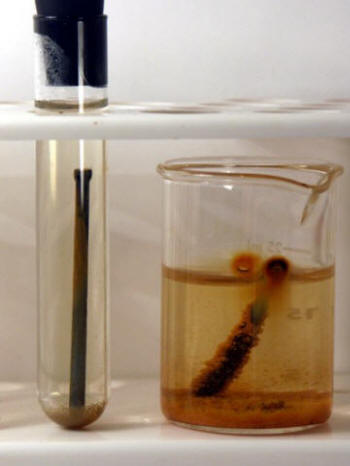|
Welcome
Site index
A to Z listing
Advertising
Books
Corrosion glossary
Disclaimer
Famous scientists
Corrosion course
Distance Ed
Doomsday scenarios
Links
Modules
Monitoring glossary
Photo gallery
Rare earths
Search this site
Textbook assignments
Toxic elements
Water glossary
Webmaster
| |
From a corrosion point of view air is roughly 20% oxygen, the balance being mostly nitrogen. Nitrogen being inert, it is used in a wide variety of industries but generally only for two purposes. One is to prevent degradation of foodstuffs, chemicals and metallic vessels due to atmospheric oxidation and corrosion. The other use is to enhance safety by preventing the possibility of combustion, for instance when solvents are being stored, or powders transported. | When water is present as well as oxygen, the combination can cause metal tanks and pipework to corrode, sometimes with catastrophic consequences. Tank blanketing is a technique for applying a cover of gas over the surface to prevent combustion or degradation. In absence of oxygen, water is still corrosive to steel but at a much slower rate, as shown in the picture on the right. The two 5 cm steel nails shown in that picture have been corroding in tap water for thirty days. As you can see, the test tube on the left is closed to air while the beaker on the right is completely open. There is still some corrosion activity in the test tube even if boiled water was used to fill it up initially. This is why the Titanic is corroding at a different pace than ships on the surface. | 
|

The sea-level composition of air in percent by volume at the temperature of 15°C and the pressure of 101.325 kPa. Gas | Formula | Presence | Nitrogen | N2 | 78.084 % | Oxygen | O2 | 20.9476 % | Argon | Ar | 0.934 % | Carbon Dioxide | CO2 | 0.0314 % | Neon | Ne | 0.001818 % | Methane | CH4 | 0.0002 % | Helium | He | 0.000524 % | Krypton | Kr | 0.000114 % | Hydrogen | H2 | 0.00005 % | Xenon | Xe | 0.0000087 % |
Source: CRC Handbook of Chemistry and Physics by David R. Lide, Editor-in-Chief 1997 Edition |

